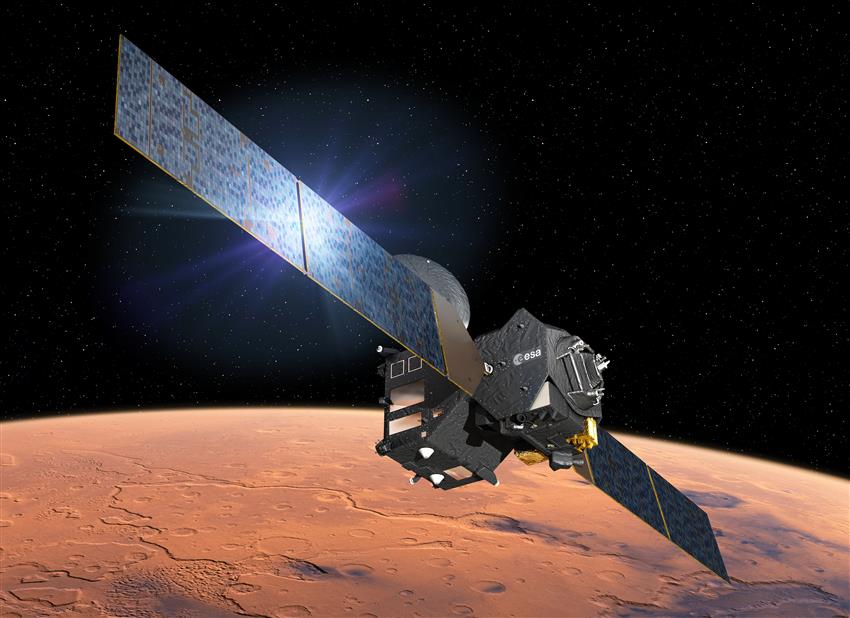ExoMars: Revealing Mars's ancient past
ExoMars Trace Gas Orbiter
- Launch:
- Arrival:
- Mission status: Active
Rosalind Franklin rover
- Launch:
The ESA's ExoMars program is a two-part Mars exploration mission.
- In , the ExoMars Trace Gas Orbiter (TGO) arrived at Mars to study the atmosphere and surface of the red planet, accompanied by an entry, descent, and landing demonstrator module known as Schiaparelli.
- The Rosalind Franklin rover will include a drill and instruments designed for biological and chemical research.
Objectives
The main scientific objective of the ExoMars program is to establish whether life ever existed on Mars. However, both ExoMars missions also aim to demonstrate key abilities that will help pave the way for future Mars missions:
- entry, descent, and landing techniques
- ability of the rover to travel several kilometres
- access to a layer of Martian soil below the surface
- sample acquisition and analysis
Landing on Mars is notoriously difficult. In fact, only about half of all attempts to land on Mars have been successful. In , the Schiaparelli module crashed on the Martian surface. Data from the anomaly was investigated, and lessons learned will be applied to future missions.
The thinness of the Martian atmosphere means that an entry, descent, and landing sequence must happen quickly and with extreme precision. When the ExoMars descent module enters the Martian atmosphere, it will be travelling at about 20,000 km/h. Its thermal shield and parachute system will slow the vehicle down, and rocket engines will fire to land the rover gently on the surface.

The Rosalind Franklin rover will land in the Oxia Planum region on Mars, some of which is seen in this image captured by the Mars Reconnaissance Orbiter. The clay-rich area was chosen mainly because of its scientific value: researchers believe that volcanic activity covered early water deposits, a process that may have preserved fragments of ancient life. (Credit: NASA/JPL/University of Arizona)
Canada's role in the mission
Thanks to a cooperation agreement between Canada and ESA, Canadian companies were able to bid on contracts for the ExoMars missions:
- The TGO carries a communication antenna subsystem built by the Canadian company MDA Space.
- The Rosalind Franklin rover will roam the red planet using a chassis and electronics built by MDA Space, and navigation cameras built by another Canadian company, the Neptec Design Group (now part of MDA Space).
The Canadian Space Agency (CSA) is funding a Canadian scientist taking part in the Orbiter mission:
- Dr. Livio Tornabene (Western University) is a Canadian Co-Investigator on the Colour and Stereo Surface Imaging System (CaSSIS) instrument on the TGO. Dr. Tornabene and his team focus on the scientific themes of impacts and composition – using orbiter data to study geological conditions on Mars. They continue to refine the calibration of CaSSIS, develop data products, and contribute to ongoing mission operations.
The CSA is also funding the participation of a Canadian scientist on the Rosalind Franklin rover mission:
- Dr. Christy Caudill (Western University) is a Co-Investigator on the PanCam instrument. She is developing novel techniques to identify specific types of minerals by linking orbital data with images taken by the rover.
Also a Co-Investigator on the PanCam instrument, Dr. Gordon Osinski (Western University) previously received a grant from the CSA for his research that would have used the panoramic images captured by the Rosalind Franklin rover to study areas of Mars that have been impacted by asteroids throughout the planet’s history.
Together, the ExoMars missions will give scientists a better understanding of the Martian atmosphere, provide clues as to whether life ever existed on Mars, and help test technologies for a future possible Mars Sample Return campaign.

